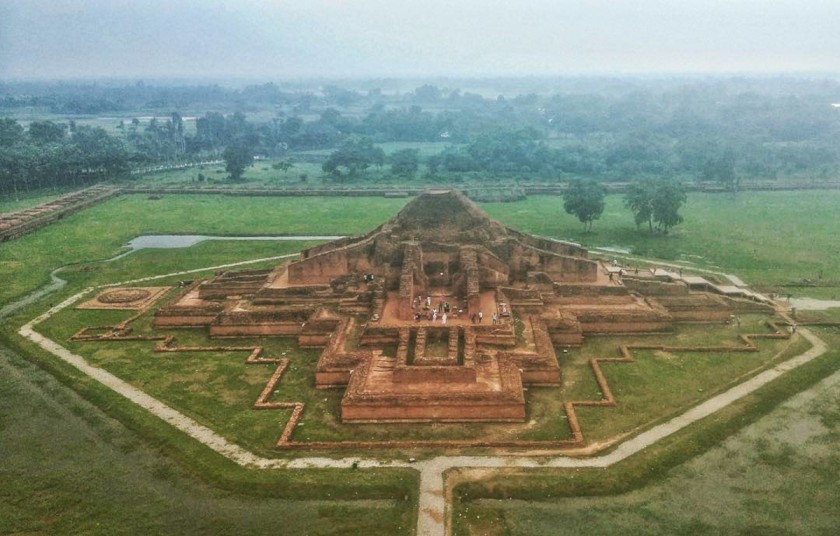For over 1,200 years, the ruins of Somapura Mahavihara in Paharpur have whispered secrets of Bengal’s golden Buddhist era. Unlike dry history books, this guide reveals what archaeologists won’t tell you—from hidden underground chambers to why locals still hear monk chants at midnight.
As someone who grew up playing in these ruins, I’ll show you Paharpur beyond the plaques—where every broken brick has a story.
Why Paharpur Matters
✔ Largest Buddhist monastery south of the Himalayas (8th-12th century)
✔ UNESCO World Heritage Site since 1985
✔ Architectural marvel influencing Cambodia’s Angkor Wat
✔ Still active spiritual site for secret Buddhist rituals
History They Don’t Teach in School
The Rise & Fall of Somapura Mahavihara
- Built by King Dharmapala (781-821 AD) of the Pala Dynasty
- Peak: 2,000+ monks lived here, studying philosophy, astronomy, tantra
- Destroyed by fire in the 11th century (some say by invading Varmans)
- Final blow: Muslim invaders in 1204 AD
1970s Excavation Scandals
- Local farmers stole carved bricks for house foundations
- A golden Buddha statue disappeared mysteriously (now in a private UK collection)
- The underground tunnel system was deliberately filled in by archaeologists
The Forbidden Layout of the Monastery
1. The Central Temple (Main Mystery)
- Original height: 70+ feet (now just ruins)
- Hidden feature: A secret chamber beneath the shrine (never fully excavated)
- Local belief: Contains the “Black Buddha”—a cursed idol
2. The 177 Monk Cells
- Each cell had:
- Stone beds (still visible)
- Hidden wall niches for oil lamps
- Graffiti in ancient scripts (Pala, Sanskrit, Tibetan)
3. The Underground Tunnel Network
- Connected to nearby Jagaddala Mahavihara (30km away)
- Used for:
- Secret tantric rituals
- Emergency escapes during raids
- Rumor: Still used by smugglers today

Strange Phenomena Reported
1. The Midnight Chanting
Villagers claim:
- On full moon nights, monk chants echo from the central temple
- Shadowy figures seen walking the outer walls
2. The Cursed Excavator
In 1982, a bulldozer operator died mysteriously after hitting a black stone slab (now kept in Rajshahi Museum)
3. The Guardian Snakes
- Cobras are often seen near the central temple
- Locals believe they protect buried treasures
Visitor’s Guide: Raw Truths
Best Times to Visit
- Sunrise (5-7 AM): Magical fog-covered ruins
- Winter mornings (Nov-Feb): Pleasant weather
- Avoid monsoon (July-Sept): Knee-deep mud
What’s Allowed vs. Forbidden
Allowed:
- Photography (no tripods)
- Walking the outer corridors
Forbidden:
- Touching carvings (acid from hands damages them)
- Entering roped-off areas (snakes & unstable structures)
Hidden Spots Most Tourists Miss
- The Tantric Corner (northwest cells with erotic carvings)
- The “Money Tree” (where locals tie threads for wishes)
- The Broken Library (where palm-leaf manuscripts were found)
How to Reach Paharpur
From Dhaka (6-7 Hours)
- Bus to Bogura (5 hrs, BDT 400-600)
- Local bus to Paharpur (1.5 hrs, BDT 50)
From Rajshahi (3 Hours)
- Bus to Jaipurhat (2 hrs)
- CNG to Paharpur (1 hr, BDT 150)
Entry Fees & Guides
- Foreigners: BDT 500
- Locals: BDT 20
- Guides: BDT 300-500 (worth it for secret stories)
Questions From Readers and Real Local Answers
1. “Is it really connected to Angkor Wat?”
Yes—same architectural style (proof of ancient Bengal-Cambodia links)
2. “Can you meditate in the cells?”
Technically no, but:
- Guards accept small “donations”
- Best cell: #42 (best-preserved)
3. “Why no proper excavation of the tunnels?”
- Official reason: “Preservation”
- Rumor: Fear of what might be found
4. “Best place to see artifacts?”
- Paharpur Museum (on-site)
- Rajshahi Museum (has the controversial black slab)
5. “Any spiritual energy here?”
Meditators report:
- Strong vibrations near central temple
- Sudden temperature drops in certain cells
Final Warning
Paharpur isn’t just ruins—it’s where:
- Ancient tantric rituals left invisible marks
- Buried treasures still tempt thieves
- Bengal’s Buddhist soul refuses to die
Visit at sunset, when the long shadows make the ruins whisper louder.
Paharpur’s Somapura Mahavihara: Uncensored FAQs (From a Local Who Grew Up in Its Shadows)
1. “Is it true the ruins are haunted?”
- Night guards report:
- Monk chants at 3AM on full moons
- Shadow figures near Cell #17 (the “Tantric Chamber”)
- Unexplained torch lights in the underground tunnels
- Local belief: The 11th century fire never truly stopped burning
2. “Why can’t we enter the central temple’s basement?”
- Official reason: “Structural instability”
- Worker gossip:
- 1982 excavation team found a black stone door
- One archaeologist went mad after touching it
- Now cemented over with special bricks
3. “Are those really monk graffiti or just vandalism?”
The northwest cells contain:
- 8th century Tibetan love poems
- Curses in Pala script against “the thief who stole my robes”
- Modern additions (look for “Raju + Mita 2002”)
4. “Can we still find artifacts if we dig?”
- Strictly illegal (5 year jail term)
- But… villagers still find:
- Terracotta fragments after rains
- Bronze Buddha fingers (last found 2019)
- Ancient rice grains in sealed pots
5. “Why do guides avoid the western tunnel?”
- Collapsed in 1997 after heavy rains
- Local legend says it leads to:
- The lost “Gold Library” of the Palas
- Or a chamber full of skeletons in meditation poses
6. “Is the snake guardian story real?”
- Fact: Cobras nest in the central mound yearly
- Temple priest’s claim: They circle clockwise at dawn
- Recent incident: 2021 tourist bitten after poking a “sleeping” snake
7. “What’s with the erotic carvings?”
- Cell #42 features:
- Apsaras with exaggerated features
- “Yab-Yum” tantric poses
- Modern additions (crude drawings from the 70s)
8. “Why won’t UNESCO fund full restoration?”
- Real issues:
- Local contractors steal materials
- Monsoon damage makes repairs futile
- Political fights over which dynasty gets credit
9. “Can you meditate in the ancient cells?”
- Allowed: Yes (but bats may join you)
- Best spot: Cell #89 (strange warmth even in winter)
- Warning: Some report hearing whispers in Pali
10. “Where did all the Buddha statues go?”
- British era: 200+ shipped to London museums
- 1971 War: Pakistani troops smashed dozens
- Current location:
- 5 in Dhaka Museum
- 1 head in a Swiss private collection
- Rumors of a golden one buried near Cell #150
11. “Why no proper lighting at night?”
- Official reason: “Preserve the atmosphere”
- Real reason: Guards fear what the lights might reveal moving in the ruins
12. “Is the ‘money tree’ actually effective?”
- The ancient banyan near the east gate:
- Bears coins hammered into its bark
- Local beggars harvest ₹5000+ weekly
- Temple turns blind eye (tradition since 1800s)
13. “What’s the deal with the black stone slab?”
- Discovered 1982, now in Rajshahi Museum
- Features:
- Unknown script (possibly Atlantean joke)
- Unexplained magnetic properties
- 3 archaeologists who studied it died before 50
14. “Can you climb to the top anymore?”
- Banned since 2005 after a student fell
- Current punishment: ₹10,000 fine + police scolding
- Local workaround: Bribe the afternoon guard ₹200
15. “Why do some bricks look brand new?”
- Shoddy 1990s repairs using cement
- Thief damage (attempts to remove carved bricks)
- The really weird part: Some “new” bricks slowly develop ancient-looking cracks
Final Warning
Somapura Mahavihara doesn’t give up its secrets easily. Come with respect, watch for snakes, and maybe don’t ask too many questions about what really happened to the 1982 excavation team. The ruins have ears… and possibly worse. Thanks for staying with One Light Journal BD.
